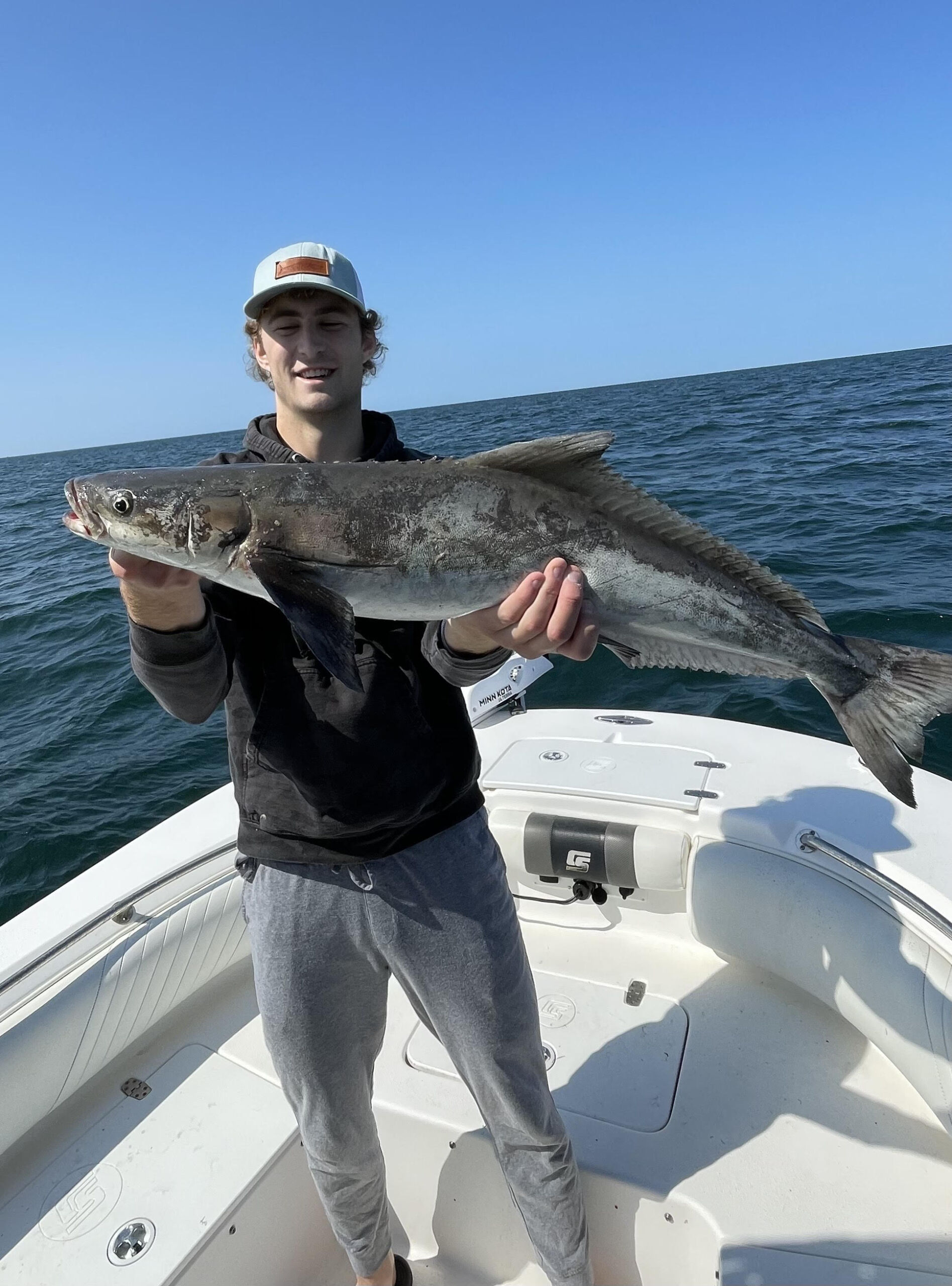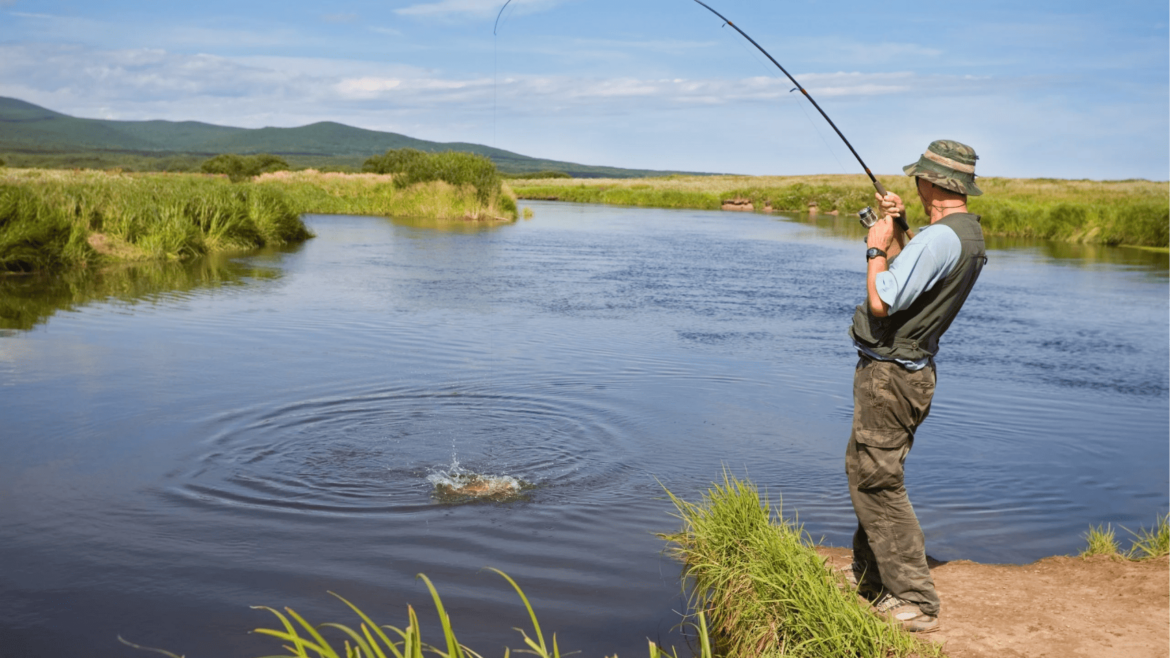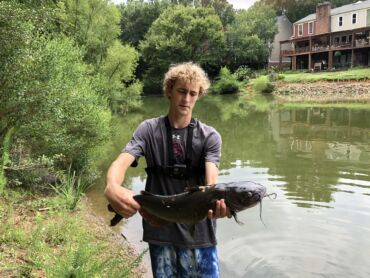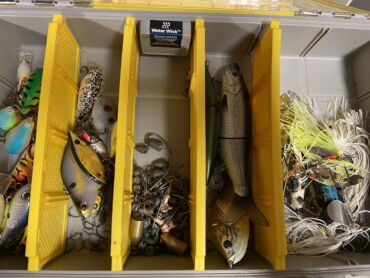Many anglers, beginners and experienced, consider river fishing one of the most relaxing ways to go angling. Not only is river fishing typically a lot more accessible than boating or lake fishing, but it can typically be done successfully from the shore, a kayak, or canoe. A pair of waders is often all the extra equipment you need for a successful river fishing expedition.
Spending a lovely day walking or wading along a riverbank sounds pretty great, regardless of whether or not you catch any fish, but catching some fish is always a great bonus. Whether you’re bait fishing, lure fishing, or fly, specific river fishing tips and techniques can improve your chances of catching a big Bass, Trout, Catfish, or whatever freshwater species you’re targeting.
If you’ve never been river fishing before and don’t know where to start, don’t worry. You’ve come to the right place!
In the following guide on how to fish in a river, tips and techniques, we’ll cover:
If you love freshwater fishing, be sure to check out this article, How to Maximize Your Catch: Guide to the Best Freshwater Fishing Baits, to learn everything you need to know about maximizing your catch in freshwater and choosing the best baits for your favorite freshwater species!
When it comes to fishing in rivers, especially rivers that you’re unfamiliar with, such as finding the best local hot spots, including secret places that only the locals know, Fishbox App, a premium Fishing App, could be perfect for you! Thanks to the Fishbox App, you’ll know the best time to chase those big Bass, Catfish, and Trout and when you’re better off relaxing at home or cleaning your tackle box.
Get your personalized fishing map
Answer a quick quiz and get your own personalized fishing map
Expert Opinion on River Fishing

Pierce Latta
16 years fishing experience
“For starters, fishing rivers has never been a strong suit of mine. I’ve been fly fishing on some rivers out west a few times, but aside from that, I’m very much a beginner. However, after reading this article, I can confidently say that I feel far more equipped to tackle river fishing than before.
One of the things I loved about this article comes at the very beginning, where it talks all about scouting out the river beforehand. Just like with any other type of fishing, the preparation work is hugely important in determining whether or not your day will be successful. The article gives a few helpful tips, such as looking for bends, obstacles, eddies, and other places where fish are likely to be hiding and waiting to attack prey.
Additionally, the article touches on the importance of seasons in river fishing. Rain and other weather play huge roles in water level, fish activity, disability, and so much more. I can’t even tell you how many times I’ve been watching River Monsters, and the host, Jeremy Wade, mentions something about the weather conditions or seasonal effects of weather on the river. Even when I was fishing for smallmouth bass in a river, we had to be extremely careful of the weather so we didn’t get stuck in a dangerous situation with fast-moving water.
Additionally, as someone who isn’t all that familiar with river fishing, I very much appreciated the section of the article dedicated to talking about gear necessary to fish rivers all the way, from landing nets and waders to baits as well as rods and reels. One part of this section that really stuck out to me was that it talks about river fishing not being “one size fits all” in terms of tackle. Depending on the river you are fishing and the species you are targeting, you could be going for something as small as a few ounces or as large as hundreds of pounds. This being said, you need to plan out your day beforehand and bring the necessary gear. If you are targeting trout in a river in Montana, your gear is going to look very different than if you are targeting flathead catfish in the Mississippi River. This is just one of many examples, but it proves the point that you need to prepare for what you could possibly catch before you make it out on the water.
We get a brief section talking about some of the popular baits used for river fishing, and then we hit a part of the article that talks about the different techniques one can use to fish a river. Of the three (bait fishing, spin fishing, and fly fishing), I have only done spin and fly fishing—and the majority of that was fly fishing for trout. Though I very much want to try bait fishing in the near future, I have not done it in the past.
Shortly after, the article moves into a section discussing how to catch fish in rivers, offering some helpful techniques on your approach as well as how and where to cast your bait. Pay careful attention to this section as it offers some advice that can make or break your day on the water if you are not careful.
The second to last section is an amazing discussion on some mistakes to avoid. As many of us seasoned anglers know, the ability to learn from mistakes is one of the most important aspects of a great angler. Luckily for us, some of these potential mistakes are laid out in front of us, so we hopefully don’t have to make them later. Pay attention, and feel free even to make a list of your own mistakes so that you can learn from them and not make them again.
This article truly opened my eyes to the world of river fishing, and I will definitely be trying it out more sometime in the near future. I hope you enjoyed reading the article and these comments. As always, good luck and tight lines!”
Visit his Instagram profile.
Subscribe to his YouTube channel.
Understanding River Environments
Some rivers may look just like another river at first glance, but upon closer investigation, you’ll begin to spot some subtle differences that play an essential role in how successful any potential fishing trips will be.
You have small, fast-flowing streams with shallow water and sporadic deep pools, which can be challenging to fish in, as well as larger rivers with strong currents, curves, islands, and deep water. No two rivers are exactly alike, and taking the time to learn the river before you start fishing is the best way to maximize your chances of catching fish.
While fish are generally spread out throughout a river, specific locations within the river environment are more likely to hold more significant concentrations of fish. After all, as the old saying goes, ‘It’s no use fishing where the fish aren’t!’
The first thing that you should do when you arrive at any river is take the time to do a little reconnaissance, especially if it’s your first time fishing this river. Find somewhere to park and slowly walk up and down the riverbank, observing the water. Look for structures where fish can congregate, such as natural obstacles, bridges, jetties, and pilings.
Next, look for fish or fish feeding activity. This is much easier to do when the water is calm. Look for fish rising to the surface and feeding or fish hanging back behind obstacles where they can relax out of the faster-moving current, ready to pounce on unsuspecting baitfish.
Try to find bends in the river rather than large, straight stretches of water. Bends in the river allow fish to congregate around behind the bed, out of the current. Obstacles such as small islands are also natural places where larger fish will wait to ambush smaller fish and crustaceans.
Rivers with calm areas that transition into fast-moving water are always great as they give the fish more opportunities to hunt and feed out of the faster-moving current, where it’s harder for small fish to congregate.
Seasonal Effects On River Behavior
Just like no two rivers are the same, the same river can be vastly different depending on the season and local weather conditions. Unlike the ocean, which remains essentially the same except for exceptionally large or violent storms, rivers can change drastically with the slightest change in the weather or season.
Depending on where you live during the cold winter months, your local rivers may partially freeze. Periods of rain will cause the current to increase along with the water levels, and in summer, the heat and sunshine will cause river levels to fall drastically, causing fish to seek shelter in the deepest pools scattered throughout the river until the water levels rise again.
Once you understand the river you plan on fishing in and consider environmental factors such as the season and weather, you’ll be ready to take the next step: choosing the right fishing gear for river fishing.
Essential Gear for River Fishing
Choosing the right fishing equipment and tackle can mean the difference between a successful day relaxing and catching fish at your local river and a stressful day battling local conditions. In the following section, we’ll take a look at essential river fishing equipment and some extra fishing gear that can make your next river fishing trip a lot easier.
Essential River Fishing Tackle
You need to tailor your fishing equipment to not only the species you’re targeting but also the type of river you plan on fishing. Big fish require heavier rods, reels, and tackle, while you can get away with lighter rods, reels, and tackle if you’re targeting smaller fish.
Likewise, your style of angling also determines what tackle you choose. If you’re all about the sport of fishing, including catch and release, then light tackle, which gives the fish more of a fighting chance and makes catching them more challenging, is a great option. However, if you’re just looking to land a fish for dinner, giving yourself the best chance of doing that with heavier tackle is a good idea.
There’s no one-size-fits-all approach to river fishing tackle, but there are some factors that you should consider before committing to purchasing any new fishing tackle, including:
- What species are you planning on targeting?
- Are you fishing for sport or to catch your dinner?
- Are you bait fishing, lure fishing, jig fishing, or fly fishing?
- What’s the vegetation around the river like? Are there obstacles along the riverbank that could make fishing with a longer rod more difficult?
- Are you planning on fishing from the bank or using a kayak or canoe?
Tackle Size Matters
You’re not fishing in a large lake or the ocean where the baitfish will be big, so using big lures, baits, or jigs won’t be as effective. You need to observe the river to see what fish are eating and match your tackle type, size, and color accordingly.
Smaller lures and jigs that match the local baitfish will prove more successful than large lures that don’t look like local baitfish.
If you’re planning on fly fishing, then matching the food source is vital.
Optional River Fishing Tackle
There are a few things that can make your next river fishing experience a lot easier. Below, we’ll cover some optional river fishing equipment that will make your next fishing adventure a lot easier:
- Waders – Even if you don’t plan on getting wet, sometimes it’s necessary, and having a good set of waders can save you from stripping off or getting wet.
- Landing Net – Depending on the riverbank, if you’re lucky enough to catch a fish, landing that fish can be quite tricky due to slippery edges, vegetation, the steepness of the bank, the size of the fish, and the tackle you’re using. The last thing you want to do is lose a monster fish because you didn’t have a safe way to get it on the bank.
- Chairs and Rod Holders – If you’re bait fishing, a comfortable chair, and some rod holders can make waiting for that bite to happen a whole lot more relaxed.
Read also: The Best Bait and Lures for Largemouth Bass Fishing
Selecting the Right Bait and Lures
If you want to catch fish in rivers, you need to use bait that the fish in the river are eating. While a fish will occasionally eat something just because it’s something it’s curious about, fish will generally be less hesitant to strike a bait they’re used to eating all the time.
Some of the most common freshwater baits include:
- Worms.
- Leeches.
- Minnows.
- Crayfish.
- Crickets.
- Grasshoppers.
If you’re planning on chasing large bottom feeders like Catfish or Carp, cut baits (cut-up fish or meat) or dough balls (homemade bait and burley recipes) will perform well and help attract fish to your bait.
Trout, Perch, and Bass prefer natural baits such as worms, minnows, crickets, and grasshoppers, but most fish are opportunistic hunters that will eat a wide variety of baits if they come across them in the water.
The biggest area to focus on is presentation. Live baits will perform exceptionally well in rivers when presented and hooked effectively, allowing the bait to move or wriggle naturally in the water. If you’re planning on using live bait, be sure to swap them out regularly.
Techniques for River Fishing
When it comes to river fishing, you have three main options:
- Bait Fishing.
- Spin Fishing.
- Fly Fishing.
1. Bait Fishing In Rivers
Bait fishing is the easiest and cheapest way to get into river fishing. You don’t need an expensive rod or reel. Just a basic rod and reel with lines, hooks, and a sinker is all you need to catch fish. You have various bait options, and you don’t need to cast far out into the river. You can sink your baits to the bottom of the river with a sinker, allow them to float or sink naturally, or add a float and have them move around in the current. If you don’t have access to a rod and reel, you can always use a handline.
2. Spin Fishing
Spin fishing requires a similar rod and reel to bait fishing, but you need a lightweight rod that will allow you to accurately cast lightweight lures and jigs. If you’re new to an area, try dropping into a local tackle store to get some advice on lure and jig selection. If that’s not possible, match lures and jigs to the baitfish your target species is feeding on. In rivers, a lot of fish congregate against the edge of the bank, so casting up and down the river edge rather than into the center is typically more effective.
3. Fly Fishing
Fly fishing is one of the hardest methods of freshwater fishing, the most expensive to get started in, and the most challenging. It will require a specialized fly fishing rod and reel, flies, dry and wet, waders, and patience. It takes a while to master the art of casting a fly rod, and you need to be careful of hazards such as branches and trees, which can snare your line. The best flies to use are flies that resemble the insects and small prey items the fish are feeding on.
Best Practices for Catching Fish in Rivers
Catching fish in a river sounds easy, with far less water to cover, but there’s also less fish compared to oceans and estuaries. Because of this, you need to know where to focus your attention when river fishing.
Avoid casting out into the middle of the river, where the current is at its strongest. Start by looking for natural obstacles, such as rocks, fallen trees, and islands, which break up the natural water flow and give larger fish ambush opportunities. Fish will allow the current to do a lot of work for them, bringing them their food, so use that to your advantage when targeting them.
Don’t rush straight over to the river edge, making a lot of noise and scaring fish away. You’ll be surprised at how many large fish are hugging the edge of the riverbank. Take your time, approach slowly, and don’t make any noise while you scout potential fishing locations.
When you catch a fish, avoid dragging it up onto the bank. A landing net is a much safer and healthier way to catch a fish, and not only does it reduce the risk of the line breaking, but it also prevents you from damaging the fish’s scales or slime coating if you plan on releasing it. A set of waders and a landing net is an excellent addition to any river angler kit.
Common Mistakes to Avoid
If you’re just getting started river fishing, below are some common mistakes to avoid if you would like to increase your catch rate and reduce the amount of time you are spending fishing:
- Remember the Current – Depending on the current or flow of the river you’re fishing in, you’ll need to adjust where you cast your bait or lure. Fast-flowing currents will quickly move your bait or lure out of the strike zone, so adjust your cast accordingly.
- Use the Right Bait – Match the catch! Match the bait you’re using to the food the target species is eating in the river that you plan on fishing.
- Be Quiet – Although the natural sounds of the river will cover a lot of the noise you make as you approach the riverbank, try to avoid breaking branches and loud noises that can startle fish lying close to the bank’s edges. While you’re being stealthy, avoid wearing bright-colored clothing.
- Be Flexible – Weather changes, and so do the water levels and current speed in the river. Just because a spot produced fish last time doesn’t mean it will next time. You need to be flexible in where and how you fish.
Read also: Best Barometric Pressure for Fishing: Ultimate Guide
River Fishing FAQs
Below are some river fishing FAQs:
How do you fish in a river with a strong current?
Look for structures such as islands, fallen trees, rocks, or artificial obstacles such as bridges, pylons, or jetties, which will obstruct the natural flow of the water and provide a place for bigger fish to ambush smaller fish.
How to read a river before you start fishing?
Take your time and walk up and down the river looking for obstacles, bends in the river, eddies, deep pools, overhanging cover such as branches and trees, or any locations where fish could be waiting to ambush their prey.
What equipment do you need for river fishing?
Depending on the size of the river and the target species, river fishing requires only basic equipment such as a lightweight rod and reel, fly rod, and light tackle. Optional equipment includes rod holders, chairs, and waders.
What are the best baits for river fishing?
Match the catch! Look at what fish are feeding on in the river and try to match it with your bait choice. Small minnows, crustaceans, worms, and grubs are always a good choice.
What size hooks should you use for fishing in a river?
Your hook size will depend on both your target species and bait. Don’t get carried away by using small baits and large hooks if they’re not necessary to catch your target species.
How to Fish in a River: Tips and Techniques – Conclusion
There you go! Everything you ever wanted to learn about how to fish a river, including understanding river environments, essential gear for river fishing, choosing the right baits and lures, effective river fishing techniques, common mistakes to avoid the next time you fish a river, and river fishing FAQs.
Get your personalized fishing map
Answer a quick quiz and get your own personalized fishing map
If you want to maximize your time fishing in freshwater rivers and catching bigger fish more frequently, then you’ll need a little help, and the premium fish forecasting application Fishbox will be perfect for you! The Fishbox App utilizes accurate weather, tide, and fishing conditions to predict the best time to get out on the water to catch your target species.
Do you have a lot of experience fishing in rivers and knowledge to share with new anglers? Then, drop a comment below with your river fishing tips and tricks.


